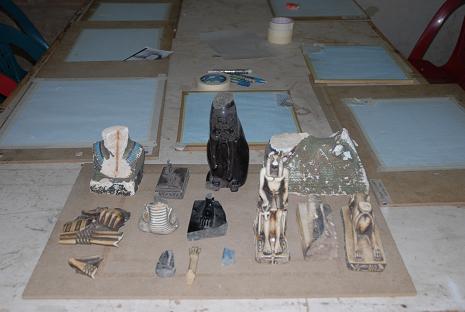Today, Marina Milić came to the Lab to give a lecture on lithics drawing to the Illustration class of the Field School. The class is steaming ahead in all aspects of the course, as is their enthusiasm for the assignments that Will Schenck has given them.
The other day, Will sent his teaching assistant Yasser to go to the nearby tourist Panorama on the Plateau to buy some cheap tourist junk so they can practice the various aspects of drawing they’ve learned so far.
Ever resourceful, Yasser was back in a flash with a bag of broken trinkets that the shop keepers gave him for free – worthless to them but priceless to the class – result!

Junk students used to practice drawing.
The Royal Administrative Building (RAB) is the next area of the settlement to be published. On Monday, we had a meeting in the Lab with the specialists currently present at Giza, as well as the excavator and author of the RAB final report, Freya Sadarangani. Our boss, Mark Lehner, also attended.
In all, we had 12 people discussing their findings – artifacts, pottery, animal bones, lithics, plant remains and pigments in relation to the temporal and spatial results from the excavation. The graphics to illustrate all of the above are produced by our GIS team (i.e. Geographical Information Systems), currently represented in the field by Camilla Mazzucato.
This meeting, as well as successive SKYPE sessions between Boston, London, Warsaw, Cairo, Nice, and Ann Arbor, is designed to gradually acquaint ourselves with each others results as our individual research progresses. In March, we have an RAB Workshop to present our final results prior to publication.
The long and gradual path towards the publication of a well integrated final excavation report is well worth the effort since it clearly offers a more informed interpretation than the use of any single source of evidence alone. It’s important and, hey, if it was easy, everyone would be doing it!

GIS map showing stone excavated in the RAB.
This week, after a logistic hiccup with the water supply, we began our flotation and wet sieve programs in earnest.
Flotation is used to recover ancient plant remains (preserved by charring) using water since luckily, plant remains float.
Wet sieving is used to retrieve those items not recovered during dry sieving on site and is particularly useful for finding mud sealing fragments, small lithic flakes and animal bone.
Apart from the samples taken for flotation, 100% of the soil excavated from the site is wet sieved – a massive undertaking but worth the invested effort (and more about our mud sealings next week).

Wetsieve materials drying outside the Giza lab.
Speaking of water, it rained twice this week (a relatively rare event) and it’s still cold enough for jackets and scarves. On Thursday, the sand storms were bad enough to close both sites though we kept the Lab open. Wild weather, though no doubt in a month we’ll be complaining about the heat.
Bye for now,
Mary Anne
